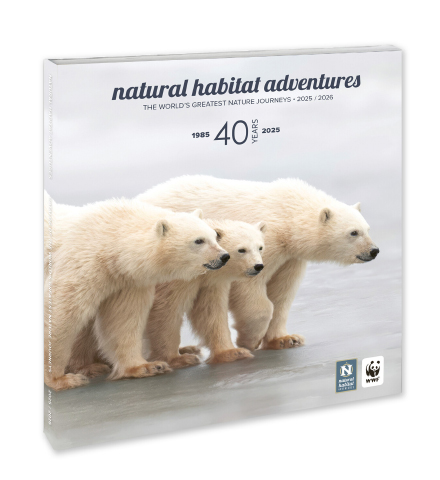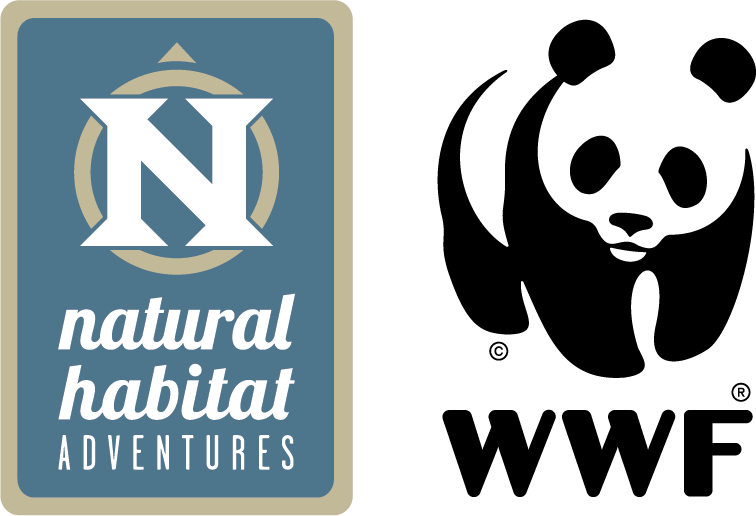Andrea Norgren, Senior Manager of Communications, at the WWF Global Arctic Programme, traveled to Greenland, with Natural Habitat Adventures at the beginning of August 2024.

© Jeff Lawrence / Nat Hab
My trip in August to southeastern Greenland was an eye-opening experience, filled with stark contrasts that showcased the beauty and fragility of this remote region.
Southeastern Greenland, including the Sermilik Fjord where we were for many days, is a dramatic testament to the Earth’s past. The mountains that rise sharply from the ocean are primarily composed of Precambrian gneiss and granite, some of the oldest rocks on the planet, dating back over three billion years. It was humbling to stand among these ancient formations, shaped by tectonic forces and carved by glaciers during the last Ice Age.

© Malene Lynge / WWF-Denmark
The banded gneiss and solidified granite reveal a history shaped by immense pressure and time. Both are rocks that had once been molten, now solid and unmoving, set against the ever-changing ice and water that surrounded them.
Finding serenity amidst the wilderness
Each morning at Nat Hab’s Base Camp Greenland, an expedition lodge with tent cabins located on the east side of Sermilik Fjord, our small group would gather on the rocks, following the lead of a fellow traveler and new friend who guided us through yoga poses. The setting was surreal—and I was calm and focused, breathing in one of the planet’s most remote and untouched landscapes.
Over the five days while we were at the Base Camp, we hiked in the mountains surrounding the Sermilik Fjord many times. We were rewarded with sweeping views of the fjord, where jagged mountains and vast expanses of ice stretch as far as the eye could see. We also kayaked among towering icebergs that felt almost alive, groaning and shifting as they interacted with the water and wind.

© Malene Lynge / WWF-Denmark
Amidst it all, there was always laughter—a sense of connection and warmth between this incredible group of fellow travelers witnessing together the magic of this remote area of the Arctic.
Taking in the natural beauty
At first glance, this part of southeastern Greenland appears almost devoid of life. The vast expanses of ice and rock seem inhospitable, and wildlife sightings were rare. But as I spent more time in this stark environment, I began to notice the subtle signs of a rich biodiversity. The ground beneath my feet was often cushioned by lichen and moss, resilient organisms that thrive in the harshest conditions. Wildflowers, small but vibrant, dotted the landscape, adding unexpected splashes of color.

© Anthony Amsel / Nat Hab
There were also more birds than I initially realized. Gulls, ravens, and snow buntings brought sound and movement to the otherwise quiet backdrop. But the true stars of the show, for me, were the whales. On our boat trip from Tasiilaq to our camp near Sermilik Fjord, we were treated to the sight of many humpbacks. Watching these majestic creatures surface and feed, often near the towering icebergs, was a reminder of the interconnectedness of all life in this fragile ecosystem.
One of the most surprising aspects of southeastern Greenland was the sound. Despite its remoteness, the region is far from silent. The ice, which dominates the landscape, has a life—and a voice—of its own. Although we didn’t see any dramatic ice-calving events, the icebergs were constantly cracking, shifting, and even flipping over, creating sounds that echoed across the fjord.
Facing an uncertain future
Our visit to local towns, such as Tasiilaq and the tiny village of Tinit gave us a glimpse into the lives of the communities that have lived and survived in this harsh environment for generations. Their way of life is closely tied to the natural world, but that is changing. Traditional hunting and fishing practices are being disrupted as the people who call Greenland home must adapt to an increasingly unpredictable climate.

© Anthony Amsel / Nat Hab
Despite the hardships, there was a warmth and friendliness among the people we met—a resilience that has developed through generations of living in one of the most challenging environments on Earth. Yet, there was also a palpable sense of uncertainty about the future.
The Arctic is warming four times faster than the global average and the effects are visible everywhere. Summer sea ice is shrinking rapidly and the icebergs we saw are calving at an unprecedented rate. The Greenland ice sheet is losing mass at an alarming pace, which is contributing to global sea level rise.
My journey to southeastern Greenland was one of profound contrasts. The beauty of this remote and rugged land is undeniable, but so is its fragility. The choices we make now will determine the future of places like southeastern Greenland—and the people and wildlife who depend on it. And while the contrasts I experienced on this journey will stay with me forever, so will the urgent need to protect the Arctic from the devastating effects of climate change.

© Anthony Amsel / Nat Hab


























